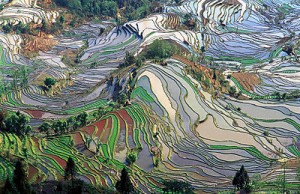 Robbins, Paul. 2004. Political Ecology. Oxford: Blackwell Publishing.
Robbins, Paul. 2004. Political Ecology. Oxford: Blackwell Publishing.
Paul Robbins’ Political Ecology offers a sweeping and surprisingly complete overview to this exciting body of work and practice. I like the way Robbins bills it as, more than a body of knowledge, political ecology is “something people do” (xviii). But the way he describes it, it seems that he limits this “doing” of political ecology as something limited to researchers working within its frameworks; I would expand this doing to also encompass the praxis of political ecology enacted by the putative subjects of this research as well. In this respect I found it surprising that Arturo Escobar’s work is never mentioned or cited in the book. That’s my only complaint about this tremendously useful book.
Robbins defines political ecology as “empirical, researched-based explorations to explain linkages in the condition and change of social/environmental systems, with explicit consideration of relations of power. Poltical ecology, moreover, explores these social and environmental changes with normative understanding that there are very likely better, less coercive, less exploitative, and more sustainable ways of doing things” (12). Repeatedly, he’s adamant that this view of political ecology does not mean a “return” to previous more “pristine” relations and environments, but rather a forward-looking endeavor from where things currently stand.
One of the most interesting parts of the book was the intellectual history he traces in the emergence of the field. Along with a deeper history (e.g. Kropotkin, Humboldt), he shows how political ecology organically grew out of “critical development research, peasant studies, environmental history, cultural ecology, and postcolonial theory” (xviii). Political economy, of course, also looms large across all these subfields, and his positioning of political ecology firmly reflects this. What I find so appealing about political ecology is its emergence in critical response to the innovations provided by these fields; in this sense, political ecology is not an amalgam of these other approaches—it’s a kind of critical sublation.
Robbins traces four main narratives in the field: degradation and marginalization, environmental conflict, conservation and control, and environmental identity and social movements. He summarizes these narratives toward the end of the book (206-207): Degradation and marginalization is posited as a “regionalized phenomenon conditioned by trans-regional patterns of accumulation” and declining marginal production mediated by the actions and adaptations of producers. Conservation is painted mainly in terms of governmentality and state territorialization that depends on particular constructions of “wilderness” and the disruption of localized historical forms of social ecologies. Environmental conflicts turn around differential access and responsibilities vis-à-vis resources and “property” regimes that are strongly articulated with the inclusions/exclusions of social differences (ethnicity, class, gender, religion). Finally social movements are constituted by the “differential risk and ecological injustice that developments from uneven development” and the conflicts cited above. Central to such processes are struggles over producer livelihoods that are not always hostile to ideas of “development” and “modernization.” In this vein, he’s careful to ward against romanticizing such movements or resorting to strategic essentialisms.
Robbins is critical of hard “constructionist” approaches to nature and suggests that we should be related careful about the way we think about environmental destruction and degradation. He suggest that approaches that treat nature as “produced” provides more nuanced ways of approaching nature and environmental conflicts. He also suggests that replacing “peasant” with the broader term “producers” also helps cast a wider analytical net that simultaneously keeps open possibilities of broader alliances between “producers” in rich and poor countries. Another critical suggestion that Robbins makes is that scalar articulations (spaces, actors, forces) should be analytically posed in terms of “networks” rather than previous frameworks defined by sequential “chains of explanation” or “bottom up” approaches. His final suggestion is for more “hybridity” in analysis between human and non-human (or more-than-human) geographies.
These suggestions inform Robbins’ notion of political ecology as “an intellectual investigation of the human–environment interaction, and as a political exercise for greater social and ecological justice” (xix).

Pingback: Political Ecology, II | Territorial Masquerades
Pingback: Agrarian Political Economy & Ecology | Territorial Masquerades
Pingback: Narco-Geographies, Part II: Political Ecology of the Drug Economy | Territorial Masquerades